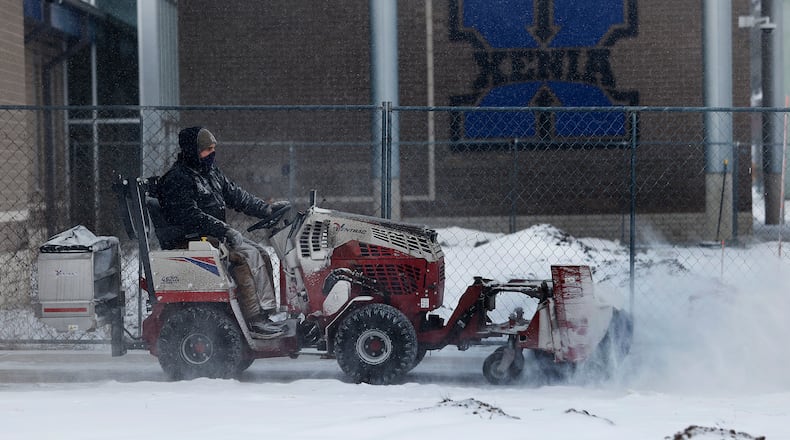“In 15 years, it has not gotten easier,” said David Jackson, the superintendent of Northridge schools. “I still stress about it, whether you make the right or wrong call.”
District superintendents know that when they make those calls, it can throw off an entire day of instruction.
Dayton Public Schools Superintendent David Lawrence said he tries to tell the community the day before if there will be no school the next day.
“I want you to be able to let your grandmother know that you’re not going to school tomorrow, so your mother can drop you off by six or seven,” he said.
If the district is making that call at 4 a.m., many of the bus drivers are already at work, Lawrence said. Dayton can’t delay the start of school either, because there are so many buildings with various start times that once busing was done for the morning, it would be time to start busing kids home, and some kids might not get home until very late.
District superintendents talk about closing with each other, but superintendents still have to make the call for their own districts.
“While we certainly understand the challenges that delays and closures have on families, ultimately we are responsible for doing our best to make sure students and staff are safe, along with anyone else that comes on district property, and that is our top priority,” said Huber Heights superintendent Jason Enix.
But there are other complexities to getting kids to school, according to local superintendents. They include food, busing, safety and the learning that takes place daily.
Food
Jackson said he worries that kids will not be able to get to school safely when the weather is bad but school is open, but he also worries about kids missing meals since Northridge provides free breakfast and lunch for all students. Some schools may still offer food for their students when the district is closed, but it can be difficult for students to get to the location.
Jackson said Northridge is thinking about getting a food truck so school employees can still feed kids on summer breaks or during days when the weather is too bad to go to school.
Lawrence said the Dayton bus drivers recently suggested a way to drop off food to bus pick-up spots when school is closed.
Fairborn superintendent Amy Gayheart said sometimes schools have heating issues or it could be dangerous for kids to get to school, two factors she’s thinking about when deciding to call for a snow day. But additionally, Fairborn offers free breakfast and lunch for students. Closing school might mean that kids miss meals they rely on as well as valuable instruction time.
“We want to keep kids safe, but we want them to be in school,” Gayheart said. “So it’s a balancing act.”
State testing
Jan. 6 was the first scheduled day back from winter break for many districts. But many canceled due to several inches of snow clogging roadways and blocking school bus’s paths.
Dayton Public sent packets home with students on Tuesday and Wednesday this week instead of holding school.
Mindy Clark, DPS executive director of support services, said that remote learning was a way to keep kids learning and ready for state tests, even though the district has not yet gone past the minimum required hours they have to have under the law. Clark said the work is reviewed once the students return.
“We really wanted to emphasize that recovery component to these remote learning days, ensuring that we know where our students are,” she said.
Jackson said he knows that remote learning isn’t the same as being in class. But he said he thinks it’s better than nothing.
But not all districts use remote learning. Gayheart said the district-submitted plan to the state does not allow for remote learning.
“For this school year, the policy that we’re operating under in the plan that has been approved by the state, does not allow for us to do that,” she said.
Other districts said they wanted to avoid remote learning because they don’t send devices home with kids daily and don’t expect all kids to have access to internet and a device.
Safety
It might not be safe to ask kids who don’t own a coat to stand in freezing temperatures to wait for a bus, superintendents said. Some said the guidelines for hypothermia and frostbite are what they generally follow.
But Jackson said one of the reasons he pushed for remote learning was to make sure teachers are checking on their students.
“There are kids who dread breaks, because we are their stability,” Jackson said. “We provide food and care and love and acceptance, and they might not get that other places.”
Buses
Many of the districts have diesel-powered buses, which have to sit on block heaters when it’s really cold outside.
On cold days where school is in session, several districts said they have mechanics come in early to make sure the buses start.
But making sure the roads are clear of snow is a roadblock. If there’s too much snow on side streets, like there was at the beginning of the year, many districts felt they couldn’t safely bus their students to and from school.
Plus, after it drops below 15 to 20 degrees, road salt is considered less effective.
“We have to make sure roads are clear, both out in the city and in our neighborhoods,” Gayheart said. “But also on our own properties, and that we’ve had time to clear sidewalks and things like that.”
About the Author

